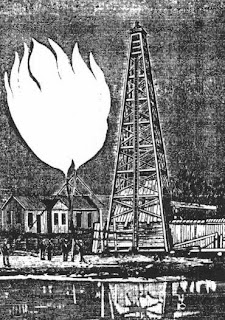 |
| "Vesuvius," in Anderson, 1887 |
The railroads had helped turn the state into a net exporter of agricultural products, though the growth of industry was still awaiting an epiphany of sorts.
That happened around 1886, when the state got gas.
Truthfully.
How this affects the Whitewater Valley is as anything affects everything else. Where there is profit, those who would profit go there.
The Indiana Magazine of History explains the consequences of the discovery of natural gas in the region:
"The eruption of real estate speculation, industrial development, commercial expansion and population growth transformed a 2,500-square-mile portion of the state from a landscape of farms, forests, and agricultural villages into a territory in which cities and boom towns dominated, each teeming with factories, neighborhoods, and commercial districts."
The last 15 years of the 19th century converted 11 counties in east-central Indiana into a hotbed of heavy industry, making the region one of the leading centers of production in the United States.
The spread in the use of natural gas did actually affect Fairfield, if we are to look back at the days when George Loper attempted to compete for business in the carriage industry. Connersville industrialist John McFarlan had secured control of natural gas distribution (out of Rush County) for his industries that created an overwhelming advantage to transform Connersville into an industrial center.
That blog item is HERE (or you may refer to the topics menu on the right).
Factories lured thousands of workers to such towns as Muncie, Anderson, Kokomo and Marion.
Go where the dough grows.
The gas supply did eventually run out around 1900 but the communities that had grown because of it found themselves with a ready supply of labor, a strong infrastructure and the capability of luring 20th century industry.
Foundries for building rail cars, automobiles, canneries, agricultural supply centers, a whole shelf of options.
As well, the farmland was still real darned good, so that business never suffered, but simply got stronger as industry brought new choices to Indiana.
Muncie's Ball Brothers dumped a ton of money into a teachers college.
 |
| Gas to waste: Indiana actually banned this display in 1891 |
IMH continues:
"There were four major railroad lines that crossed the region in 1886. Most of the county seats had managed to persuade at least one major railroad to run through their communities by the mid-1880s. Large towns, such as Muncie, Anderson, Marion and Kokomo, boasted three or more railroads. Some smaller towns in each county were also located on rail lines. The railroads connected the area with markets for agricultural and forest products."
The gas supply had actually been first discovered in eastern Ohio and western Pennsylvania and had been instrumental in helping build Pittsburgh's steel industry in the 1880s.
Gas was first struck at Portland (Jay County) in March 1886. The first well to produce enough gas to make a profit was sunk at Eaton, a town north of Muncie, in October 1886.
Evidently the gas fountain was enough to fuel an immense building boom in Madison County, where Anderson developers found nothing but profit.
There, the discovery of gas in 1887 sparked a frenzy of real estate speculation.
In Anderson, competing gas companies lured investors to see a well called "Vesuvius," the big well gushing lighted gas, a testament to the abundance of gas for industry.
In Marion, real estate values literally exploded.
"Soon after gas was discovered in 1887, two industrialists from Findlay, Ohio, named Gray and Dodds purchased land north of the Mississenewa River, which was then the northern border of the town. Gray and Dodds called their suburb North Marion and within two years had attracted the Window Glass Company, Marion Flint Glass Company, Western Glass Company, Marion Handle Works, and the Marion Paper Company to sites located on rail spurs running to the three major railroads that intersected in Marion."
Ever heard of the town of Gas City?
Research concludes that the gas boom continued to sustain existing industrial plants and to stimulate construction of additional plants in nearly every town and city of the gas belt until 1900. That year Indiana was producing the most natural gas in the United States, with $7,254,539 worth of gas produced and $5,412,307 consumed in Indiana.
Rural communities in central Indiana also began to grow. The American Window Glass Company, a large trust of window-glass manufacturers formed in the late 1890s, operated 36 factories in both large cities and small towns in the Indiana gas belt by 1900.
The glut of gas created gluttony and, by the end of the century, the industry was running on fumes.
The gas boom came to a dramatic end. Most of the small boom towns in the gas belt experienced an economic bust after 1901. A few of their factories hung on, hoping for new gas supplies or converting to other fuels. By the 1920s, most of these had closed.
Most of Indiana's bigger towns did manage to ward off complete disaster since their factories remained in advantageous locations near the railroads, and community infrastructure. They generally re-tooled and built the same things with alternate sources of fuel, though the tradeoff was cost and pollution.
Electricity helped save the day.
MORE GAS
No comments:
Post a Comment